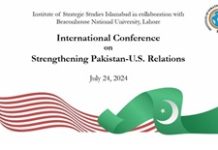Abstract
The framing and rewriting of the counter-insurgency (COIN) manual by the United States (US) post 9/11 was put into practice in Afghanistan in 2001. The counter-insurgent theorists postulated a rhetorical population-centered approach and narrative of “winning hearts and minds” of the indigenous population to achieve legitimacy and effectiveness of this asymmetric warfare. This paper sheds light on the doctrine of “securing populations” through social work parallel to the military campaign as a tactical device in the war-ravaged Afghanistan. This is presented as one of the facets of a “population-centric” strategy for the interests of the Afghan civilians. This is a critical analysis of the claims of a humane approach in devising this strategy. The humane aspect was engineered to alleviate the civilian grievances and casualties. However, the paper argues that re-framing of the doctrine couched in a rhetoric expression and empathetic language was a strategic choice to win over the indigenous populations rather than being a normative underpinning of a population-centered approach. Therefore, this paper presents a brief review of COIN literature, while focusing on US-led COIN programme in Afghanistan as a case study to raise questions on the exploitation of the civilian populations. Hence, raising a fundamental question that whether wars can ever be humane?













